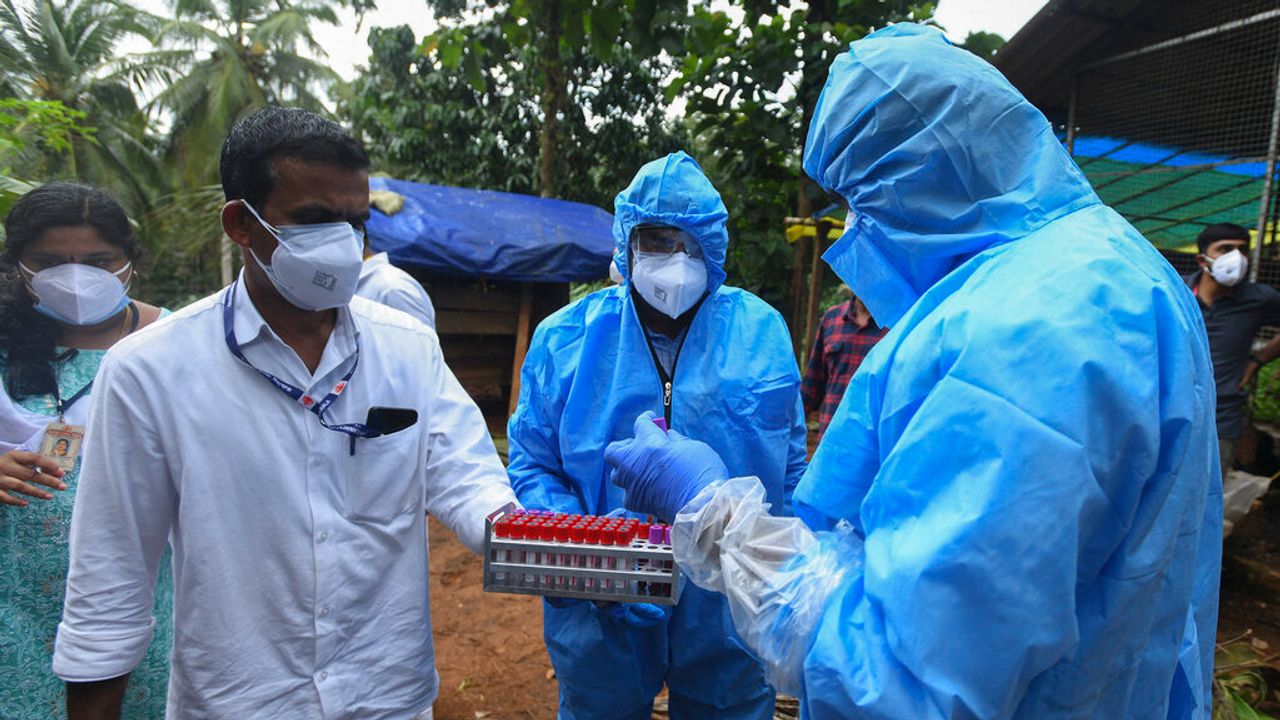Infection
Nipah virus outbreak in Kerala, India contained after 6 infections
A Nipah virus outbreak occurred in the Kozhikode district of the southern Indian state of Kerala between September 12–15. The outbreak resulted in six people being infected with two deaths, while authorities contained the outbreak through testing over 1,288 close contacts and closing several schools, workplaces and public transport networks.
According to the World Health Organization (WHO), this is the sixth outbreak of the Nipah virus in India since 2001. The outbreak, although contained, was a warning of the growing danger of zoonotic spillover events under conditions in which public health has been drastically undermined during the COVID-19 pandemic.
Nipah infection symptoms can range from nothing at all to severe flu symptoms including fever, cough, headache, shortness of breath and confusion. In some cases, the symptoms can be more severe, including the patient going into a coma, encephalitis (swelling of the brain) and seizures. The virus has a very high lethality ranging from 40–75 percent. It is a biosafety level 4 (BSL-4) pathogen, the highest level, indicating its extreme danger to humans.
Nipah virus is a member of the Henipavirus genus consisting of a single strand of ribonucleic acid (RNA). It is a zoonotic virus that lives in fruit bats of the Pteropus genus, with people becoming infected through contact with contaminated secretions. Human-to-human infection is limited to those who come in close contact with infected people. Nipah is highly contagious in pigs and is known as barking pig syndrome, and humans can become infected from contact with infected pigs. To date, outbreaks have occurred in Bangladesh, India, Philippines, Malaysia and Singapore.
Bats “can urinate and contaminate fruit, and when people eat that they get the virus and then they get sick. Once you get it, [the only treatments are] rest, hydration, treatment of symptoms,” associate professor of molecular engineering Joanne Macdonal of the University of the Sunshine Coast in Australia told the Guardian.
The Nipah virus was discovered relatively recently in 1998–99 after an outbreak in Malaysia and Singapore among pig farmers. About 300 people were infected causing 100 deaths, while over 1 million pigs were killed to control the outbreak.
The identification of the novel virus was extremely complex. At first, it was incorrectly identified as Japanese encephalitis, which is caused by the Japanese encephalitis virus (JEV) that is spread by the bite of infected mosquitoes. Japanese encephalitis has similar symptoms to Nipah infections, although its lethality is 25 percent.
Malaysian scientists and medical authorities started doubting their initial hypothesis when they found that patients were not responding to the Japanese encephalitis vaccine. After a series of patient samples were examined at the University of Malaya’s Department of Medical Microbiology, it was proposed that a novel virus might be responsible for the outbreak. The new virus was identified as being a paramyxovirus, an important viral family that also contains mumps and measles.
The biological samples were sent to the Division of Vector Borne Diseases, Centers for Disease Control and Prevention (CDC), Fort Collins, Colorado, USA, for further tests and analysis. Scientists confirmed the novel virus was closely related to the Hendra virus that had been discovered in Australia in 1994.
The new virus was called Nipah virus (NiV), named after the village of the first patient from whom the virus had been isolated in Kampung Sungei Nipah.
The Hendra virus’ natural host is the large fruit bat known as a flying fox that belongs to the Pteropus genus. The bats are known to infect horses and more rarely dogs. The infection has been largely confined to people who handle horses. Symptoms and lethality are very similar to those of the Nipah virus. The virus was named after the suburb Hendra in Brisbane, Queensland, where 19 horses became ill with 13 dying in September 1994. Two people were infected in the outbreak, with one dying.
The recent Kerala Nipah outbreak is the fourth in the region since 2021. Although the affected areas of the infections are relatively small, health authorities are concerned that with more outbreaks the virus may mutate, enabling human-to-human infection. This would be a potentially devastating consequence and pose the threat of a pandemic.
“Every outbreak is giving the pathogen an opportunity to modify itself,” veterinary physician Ausraful Islam, who specializes in bat-borne pathogens at the International Centre for Diarrhoeal Disease Research in Dhaka, Bangladesh, told Nature. “Each outbreak is a concern,” he added.
Since its discovery, the Nipah virus has extended its geographic range. After the initial Malaysian outbreak, the virus appeared in Bangladesh and India in 2001, with sporadic outbreaks since. In India there have been six outbreaks since 2001, with the most severe in Siliguri town, West Bengal, with 66 cases and a fatality rate of 68 percent. In Bangladesh, more than 100 people have died since the virus was initially found in that country.
Outbreaks occur on an annual basis in Bangladesh, which scientists believe are linked to people drinking fermented date-palm sap contaminated with bat urine.
In an important comment published in Nature in October, written by the head Nipah surveillance team in Kerala and epidemiology professor Thekkumkara Surendran Anish, titled, “Nipah virus is deadly—but smart policy changes can help quell pandemic risk,” the author notes:
To reach Kerala, the virus must have spread undetected over more than 2,000 kilometres, from Bangladesh or the neighbouring Indian state of West Bengal. It is highly probable that many places in southeast Asia have Nipah virus reservoirs and could experience spillovers: Myanmar, Thailand, Laos, southern China, Bhutan, Nepal, Sri Lanka and many Indian states all lie a similar distance from Bangladesh and are home to fruit bats. Bat populations in many Indian states harbour serological evidence of exposure to Nipah virus.
Although the Nipah virus’ infection rate is fairly low, Anish goes on to point out that it could mutate to become a pandemic risk, stating, “Because Nipah is an RNA virus that is prone to mutate, studying the virological factors contributing to severity is important for monitoring its pandemic potential.”
The WHO placed the Nipah virus along with Marburg, Ebola and others on a priority list for research because they pose the “greatest public health risk due to their epidemic potential.”
An important factor for the increased spread of the Nipah virus across the Indian subcontinent is global warming and the destruction of bats’ foraging sites, which has forced them further afield in the search for food, thereby increasing their chance of impinging on human populations.
A seminal study published in Nature in July 2022 by assistant research professor in climate epidemiology Colin Carlson and his team at Georgetown University, “Climate change increases cross-species viral transmission risk,” outlined the growing risk of zoonotic spillovers due to shifting ecosystems because of the climate crisis forcing animals to shift their habitats. A zoonotic spillover is thought to be responsible for the current SARS-CoV-2 pandemic, signifying the risk of further future pandemics.
Carlson et al. state, “Owing to their unique dispersal ability, bats account for the majority of novel viral sharing and are likely to share viruses along evolutionary pathways that will facilitate future emergence in humans.”
Bats’ unique ability to fly among mammals and the fact that they harbour numerous viral pathogens gives them an important place in future zoonotic spillovers.
Carlson and his team added:
This viral sharing hotspot is driven disproportionately by bats, because their dispersal was left unconstrained within continents; we made this choice given their exclusion from previous research characterizing the dispersal ability of range-shifting mammals, genetic evidence that flight enables bats—and their viruses—to often circulate at continental levels and data suggesting that bat distributions are already undergoing disproportionately rapid shifts… The unique ability of bats for flight could be an important and previously unconsidered link between climate-driven range shifts and future changes in the mammalian virome.
Disease ecologist and co-author of the paper Gregory Albery told the Guardian that climate change is “shaking ecosystems to their core” and causing interactions between species that are already likely to be spreading viruses. He said that even drastic action to address global warming now would not be enough to halt the risk of spillover events. “This is happening, it’s not preventable even in the best-case climate change scenarios and we need to put measures in place to build health infrastructure to protect animal and human populations.”
Governments have proved completely incapable of resolving the climate crisis, which is completely subordinate to the interests of the corporate elite. This underscores that it is the working class along with principled scientists who have identified the ecological and health disaster that must create a society based on need, not profit.




